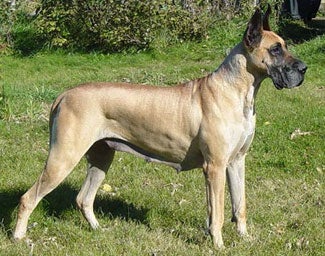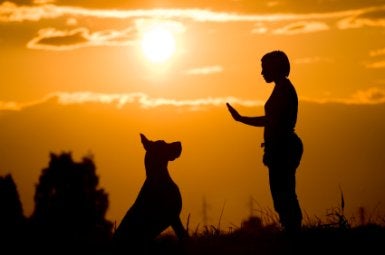Great Dane Training & Breed Information
When one thinks of a gentle giant among dogs, the first breed that comes to mind is the colossal Great Dane. This larger than life dog is sweet, gentle, and also currently the Guinness Book of World Records "world's tallest dog". Our fascination with this breed is endless. Their size, personality, and appearance are all magnetic; people can't help but be drawn to them. Where did this majestic breed come from, and what is it made of today? Read on to find out...

Great Dane History
The background and origins of the Great Dane are steeped in mystery; no one really knows exactly where they did come from. There are even tales of a dog resembling the Great Dane reaching all the way back to the time of the Ancient Egyptians and Ancient Greeks. As far as current sources know, the breed is thought to be about four hundred years old, and can be seen in paintings from the 17th and 18th centuries. It is surmised, though not recorded, that the breed resulted from a cross between a mastiff and an Irish Wolfhound, accounting for the breed's large size. Some think the dog originated in Germany, while others believe it was Denmark. Whichever country the breed did spring from, people throughout Europe called the breed "Great Dane" in various languages, and so it is to this very day.
Appearance Of the Great Dane
The Great Dane is a very distinctive dog, not only because of its size but also because of its formation and coloring. According to AKC standards a male Great Dane should be at least 30 inches tall at the withers, though preferably 32 inches or more. A male should also weigh in at 120 pounds at the very least. A female should measure 28 inches as a minimum, though preferably 30 inches or more. Any dog measuring less than the minimum is disqualified from showing. The dog also must be well proportioned and solid, not all skinny legs and towering height. Recently a Great Dane took the title of "world's tallest dog" in the Guinness Book of World Records. "Gibson", from Grass Valley, California, measures 42.2 inches at the withers. That's over 3.5 feet tall!

As far as coloring goes there are six acceptable colors for show standards. These include: fawn, brindle, blue, black, harlequin, and mantle. The fawn coat is light tan all over with a blue mask and black eyebrows and black on the tail. The brindle coat is comprised of an orange-tan base with zigzag bolts of black striping throughout. A brindle coat almost looks like tiger striping. The blue coat is a solid grey-blue color that resembles steel. Black of course is a solid coat, with preferably no white markings. The harlequin coat is made up of a base of white with irregular splashes of black. The splashes must be spread out and not look like stripes, and also must not be grey, in order to qualify for showing. Finally, the mantle coloring resembles the coat of a Boston Terrier. A solid body color is broken by white at the neck, and the face is a mask of the solid color broken by white in the middle. There are others colors bred, such as merle, white, and fawn mantle, but these are not show quality colors and are not purposely bred.
Many Great Danes in the US have their ears cropped for looks, but in Europe this practice is banned as cruel to the animal. Originally the practice was done to prevent wolves and wild boars (which were often the quarry of hunts) from grabbing onto the dog's ears, but that is no longer a consideration. Both types of dogs are accepted in showing however, cropping makes no difference as to eligibility.
Great Dane Puppy Temperament
The Great Dane isn't known as the "gentle giant" for nothing. These colossal, sweet dogs are perfect family members who are great around children and other pets. They are very family oriented, and will want to be with people the majority of the time (separation anxiety can be an issue at times). The Great Dane tends to be slow to warm up to strangers, but he should never be fearful or aggressive towards them.Surprisingly the Great Dane is not a very energetic breed; in fact they have a rather slow metabolism. This means that Great Danes usually only need a nice, brisk walk once a day to burn off energy. Unlike some high-energy dogs, such as the German Shorthaired Pointer or the Jack Russell, a Great Dane won't tear your house apart from boredom or excess energy, which is probably a good thing. Imagine the destruction a dog of that size could wreak!
Great Dane Health Issues
As mentioned before, the Great Dane has a slow metabolism, so he actually requires less food per pound than some more energetic dogs, though because he is so big it all equals out. The average life span of a Great Dane is about 8-10 years, though this can be increased with good breeding, nutrition and care. The reason a Great Dane's life is relatively short is because his massive frame puts a lot of stress on his heart. The breed suffers from congenital problems such as dilated cardiomyopathy, an enlarging and weakening of the heart which results in loss of capability to pump blood. The Great Dane also suffers from hip dysplasia, though this is a genetic condition that can be prevented by not breeding dogs with the condition. If you are going to buy a Great Dane puppy, ask to check the parents out as well and ask about their health. Any good Great Dane breeder will freely give this information.Finally, the breed also suffers from a condition known as "bloat", which is a painful distending and stretching of the intestines which can lead to death. Some vets "tack" the stomach to the right wall to prevent bloat during routine surgery such as spaying or neutering, while others only perform the procedure if the dog suffers from bloat. Like any pure bred dog, health issues are a concern with the Great Dane that reputable breeders continue to work on.

Great Dane Training
Like all dogs (especially big ones) the Great Dane requires heaps of puppy socialization and obedience training. A Great Dane who grows up without adequate socialization and training is a recipe for disaster.Great Danes respond best to positive reward based training methods such as clicker training. You won't be needing any harsh punishments or forceful corrections when training your Great Dane. It's a great idea to get along to some puppy kindergarten classes as soon as your Great Dane puppy is old enough.
Some training issues that are especially relevant to Great Danes are:
- Basic obedience training is crucial for establishing voice control over your Great Dane. It will also set you up as the trusted leader in your owner-dog relationship. If you are planning to train your dog at home this is the training course I use, and recommend that you follow - Clicker Training - Becoming A Supertrainer.
- Destructive chewing can be an issue as your puppy is growing up and going through the teething stage. You can learn how to prevent or put a stop to most chewing problems here - stop your Great Dane from chewing.
- Most Great Dane owners and breeders recommend that you crate train your puppy as soon as he/she arrives at your home. I agree with this and believe that crate training is the best way to potty train your Great Dane.
- Some other common behavior problems that are prevalent in Great Danes are counter surfing your kitchen benches, jumping up on guests and pulling on the leash. Once again you can learn how to prevent or rectify such issues by consulting this training guide - clicker training to solve problem behaviors.
Great Danes Are A Wonderful Breed
When all is said and done the Great Dane truly is a masterpiece among dogs. If you are looking for a loyal and mild dog with a heart as big as his size, the Great Dane could be the right dog for you. If you have room, both in your heart and hopefully your home, then give a Great Dane a chance. Good luck searching for your new best friend, may you both bring joy to each other.
Check Out These Cute Little Great Dane Puppies!
Great Dane Picture at top of page provided by o5com under a creative commons licence
Go from Great Dane Training to Puppy Training home page.
Please consult the services of a Professional Dog Trainer, Behaviorist or Veterinarian before implementing any of the advice contained on this site.







